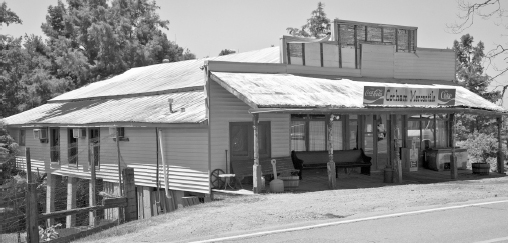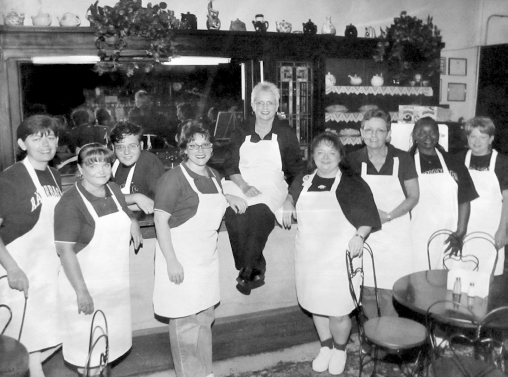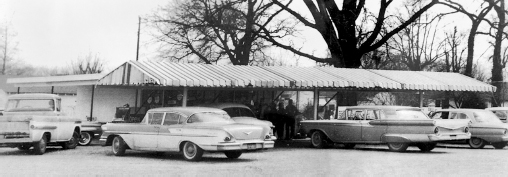
11
U.S. HIGHWAY 165
The Arkansas Delta spans the state north to south along its eastern edge, with the Mississippi River as its eastern border. Its furthest westward encroachment ends, quite literally, at the steps of the Arkansas State Capitol. Built on the first rise from the flatlands within the walls of a temporary penitentiary, the Capitol Building was first opened in 1914. Within its basement, it houses its own classic restaurant.
There will be time later to talk about that establishment, and all of Greater Little Rock’s classic eateries. The journey contained in this section of the book covers a span of restaurants along U.S. Highway 165 heading east from town, a highway that takes travelers from central Arkansas to Stuttgart (see pages 79–86).
The first of these, a block off 165 on Arkansas Highway 161, might be the most recommended and favored restaurant in the state. Its history traces back to 1917. Built over the bank of a bayou off the Arkansas River, it started life as a general mercantile store for the town of Scott. In 1984, its owners created an Arkansas icon.
COTHAM’S MERCANTILE, SCOTT
Of course, I am speaking of Cotham’s Mercantile. Longtime general store, former military commissary and criminal lock-up, today it’s a must-stop for food travelers.

Cotham’s Mercantile in Scott. Grav Weldon.
The creation of this icon began with the addition of a single table for area farmers who wanted to sit down and enjoy their lunch, rather than purchasing a wax paper–wrapped bologna sandwich at the counter and eating it on the front porch. Word got around, and it was soon discovered by that amazing eatery-seeking class of Arkansawyer that so often roots out the great restaurants like pigs hunting truffles. Of course, I am speaking of politicians. Not just any politicians, but a couple Arkansas movers and shakers by the names of David Pryor and Bill Clinton.
Back then, the place was Lee Cotham’s, and once Attorney General Pryor and Governor Clinton started frequenting the place, it took on the moniker “where the elite come to eat.” Indeed, it wasn’t long before the store was full of tables rather than merchandise; and those tables were full of folks rubbing elbows and placing those elbows on the table while two-handing the restaurant’s famed seventeen-ounce Hub Cap Burger with a side of double-dipped oversized onion rings.
These days, Cotham’s is a legendary stop on the trail to the southeast. It’s been visited by President George Bush, Food Network’s Rachel Ray and the Travel Channel’s Adam Richman, who (erroneously) attempted to eat the state’s biggest burger by consuming a Quad Hub Cap on Man Vs. Food (the state’s largest burger at the time of this writing is the five-pound patty on the famed giant cheeseburger at Ed Walker’s Drive In up in Fort Smith). When you go, don’t limit yourself to the burger. Check out what’s on the lunch special board, and be sure to try the Mississippi Mud Pie.
CHARLOTTE’S EATS AND SWEETS, KEO
A short distance farther down U.S. Highway 165 lies a little village called Keo. There’s not much to it these days, just the largely popular Morris Antiques, a handful of shops and Charlotte’s Eats and Sweets.
Charlotte Bowls didn’t set off to start a restaurant. She was going to be a caterer. In 1993, she rented out the back of an old pharmacy and started cooking. The folks in Keo were grateful for a good spot to grab a bite to eat, and they encouraged Charlotte to expand her menu. Over the years, she took over more of the building, clearing out old furniture, cleaning top to bottom and finding chairs and tables to fill the space.
Today, lines form outside Charlotte’s place each day half an hour before it opens, and there’s always a wait. Locals order by phone and come to pick up their Keo Klassic and slice of pie. The pies really are remarkable. Her coconut meringue was named best in the south by Southern Living ages ago. I went on about her caramel meringue in Arkansas Pie: A Delicious Slice of the Natural State. What can I add? Well, the fresh fruit plate with your choice of a scoop of tuna or chicken salad or cottage cheese is a gorgeous choice for a light lunch. The cakes are stunningly good if you miss out on pie, and the gobstoppingly creamy shakes are perhaps the most overlooked sweet on any Arkansas restaurant menu.

Charlotte Bowls (on the counter) with her staff at Charlotte’s Eats and Sweets. Restaurant historical photo.
SPRADLIN’S DAIRY DELIGHT, ENGLAND
A little community east of Little Rock may be home to the place where the Frito chili pie was created. I kid you not. Back in 1957, a man by the name of Claude Spradlin decided to open a dairy bar in the town of England, mostly because there wasn’t already one in town and it seemed like a good idea. Claude’s wife had worked at one in her hometown, so he opened up Spradlin’s Dairy Delight.
Back in the 1950s and ’60s, the restaurant came to be known for three things—burgers, footlongs and the Frito chili pie. Claude charged a nickel for the Fritos and a dime for the chili, and it caught on. He eventually received notice from the Frito Lay Corporation, which sent him a letter thanking him for his contribution.
Claude’s son, Claude Spradlin Jr., took the place over in 1973. The younger Spradlin has always been around the restaurant; it first opened when he was seven. He took over grill duties at the age of sixteen and says he may have cooked more hamburgers than any man in America over the past fifty years. At the age of sixty-four, he’s still manning the grill and having a good time. He says he visits each day with his buddies and has some great regular customers. And he has no intention of retiring.

Claude Spradlin opened Spradlin’s Dairy Delight in England in 1957. Courtesy Claud Spradlin Jr.
HARDIN FARMS & MARKET TOO, SCOTT
I mentioned back on page 62 that there was more to the story of the Hardins of Grady. The story is two-fold. In 2010, Randy Hardin moved to Scott to start another farm. Hardin Farms and Market Too is the next iteration of the Hardin family’s agricultural bent, and son Josh Hardin has been instrumental in bringing in fresh produce for sale. The restaurant’s also great for very smoky barbecue. I have been known to stop in and pick up a smoked chicken or two to take home.
It’s Josh’s older brother, though, who’s waving the banner for Delta farmers most fervently. Jody Hardin’s efforts can be considered one of the cornerstone moments for the birth of the Arkansas locavore movement. Born in 1967, he took up farming with his family as a teenager. He headed off to college after high school but returned in 1994 to save the farm. As I’ve heard him mention before, “The irony of the Delta is it’s beautiful but so hard to survive in.”
Jody has been seeking out every way he can to help fellow farmers. In 2005, he spearheaded a basket-a-month program to bring produce, eggs, milk and meat from farms to city dwellers. In 2008, he moved to North Little Rock and, under request from then-mayor Patrick Henry Hays, he started up the Certified Arkansas Farmers’ Market, which requires its members to verify that they are the source of the products they sell. In 2010, he was one of the key elements in the opening of Argenta Market, the first grocery store in the area to specialize in local produce (the market closed in 2014).
Hardin will tell you, he just really wants to be a farmer. But there’s something in his down-to-earth demeanor that makes him a natural salesman and leader. Bedecked with hat and clad in jeans and boots, he’s become an icon.
His latest effort has been to help farmers in the Delta grow organic and sell produce to its low-income communities at reasonable prices. He spent ten years knocking on the door of Heifer International, pointing out the plight of struggling farmers here at home (the organization is best known for helping impoverished families in other countries by sending them cows, chickens and other animals to help communities, especially women, to become self-supporting and sufficient). Heifer responded, and the Seeds of Change Initiative, a campaign to build resilient local economies and end poverty through the extraordinary potential of locally produced food, was born (to learn more, please head to heifer.org).
Today, Hardin spends much of his time in a 5,600-square-foot Italian villa on sixty-three acres of rich pastoral land. In 2013, the city of North Little Rock approached him and asked if he’d like to take over the aging Saint Joseph’s Center of Arkansas. The former orphanage, built around 1910, was empty and available. Hardin jumped at the chance, working not only to secure funding for a new nonprofit hybrid farmer innovation center but also to transform the land around the building into an urban garden. At the time of this writing, he’s busy terracing the hilltop on which Saint Joseph’s Farm sits and is working to overturn the city’s ban on raising goats.
He’s also working on a buy-in program, where families put down money and receive food from Delta farmers throughout the year. The money helps keep those farmers afloat, along with grants Hardin has secured to help them move into organic production. Those families receive the bounty of fresh produce, and Arkansas comes that much closer to coming full circle, celebrating its own agricultural treasures.